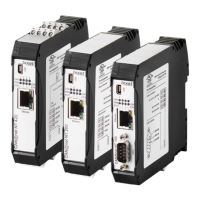
Do you have a question about the HMS Networks Ixxat CAN@net NT 100 and is the answer not in the manual?
| Category | Gateway |
|---|---|
| Ethernet Standard | 10/100 Mbit/s |
| Product Type | CAN@net NT 100 |
| Ethernet Interfaces | 1 x Ethernet |
| Power Supply | 9 - 30 VDC |
| Operating Temperature | -20 to +70 °C |
| Protocols | TCP/IP, UDP |
| CAN Bitrate | 10 kbit/s to 1 Mbit/s |
| Operating Voltage | 9-30 V DC |
This manual addresses trained personnel familiar with CAN, CAN FD, and national standards.
Lists other relevant documents for the CAN@net NT product family and its configuration tools.
Provides a version history of the manual, detailing changes and release dates.
Information about the Ixxat brand and other trademarks mentioned in the document.
Explains formatting, symbols, and notations used throughout the manual.
Lists essential precautions for handling, operating, and storing the device to prevent hazards.
Describes the intended application of the CAN@net NT devices for connecting CAN and CAN FD networks.
Outlines the main technical specifications and capabilities of the CAN@net NT series devices.
Explains the initial configuration state of the CAN@net NT devices upon delivery.
Details the ASCII Gateway mode for connecting CAN systems via Ethernet using ASCII protocol.
Explains Local CAN Bridge and CAN-Ethernet-CAN Bridge modes for connecting multiple CAN networks.
Information on the Lua Application Development Kit for extending device functionality with scripts.
Details the C-API for accessing CAN@net NT via ASCII protocol for C/C++ applications.
Step-by-step guide for installing the necessary software, including VCI driver and CAN-Gateway Configurator.
Instructions for physically installing the CAN@net NT device and connecting cables.
Outlines various methods for connecting the CAN@net NT device to a PC for configuration.
Guides through the initial setup and connection of the CAN@net NT device using the CAN-Gateway Configurator.
Describes the physical Ethernet port, its pin allocation, and connection specifics.
Explains the function and purpose of the Mini USB port for device configuration.
Explains the status indicated by the Power LED on the CAN@net NT device.
Details the different states and meanings of the Status LED on the CAN@net NT device.
Describes the function of the User LED, which indicates primary application status.
Explains the status indicated by the Ethernet LED for communication status.
Details the meaning of the Link Speed LED, indicating the Ethernet connection speed.
Explains the Link/Activity LED status for Ethernet interface connection and activity.
Describes the status indicated by the CAN LEDs (1-4) for the CAN interface.
Information on how to contact technical support for the CAN@net NT product.
Steps for returning hardware, including registering for RMA and packing instructions.
Details the product's compliance with the Electromagnetic Compatibility Directive (CE).
Details the product's compliance with UK Electromagnetic Compatibility Regulations (UKCA).
States the product's compliance with Part 15 of the FCC Rules and operational conditions.